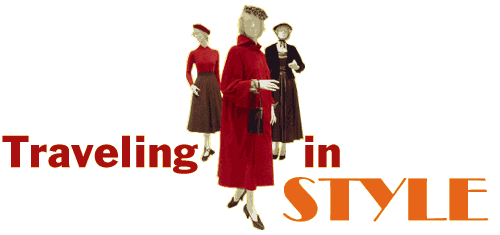
Developments in rail, air, sea and automobile transportation around
the turn of the 20th century not only made it easier for more people
to travel, they inspired changes in the way travelers dressed and
pampered themselves. That's the focus of an exhibition at the Rhode
Island School of Design in Providence, Rhode Island. Tom Verde has this story.
Traveling in Style
by Tom Verde
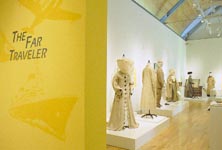 The popular, though unsubstantiated, origin of the word posh
is that it's an acronym for "Port Out, Starboard Home", where the
first class berths were on Titanic-era luxury liners. While this
theory is questionable, there's no doubt that the accommodations
on-board these ships were, well, pretty posh.
The popular, though unsubstantiated, origin of the word posh
is that it's an acronym for "Port Out, Starboard Home", where the
first class berths were on Titanic-era luxury liners. While this
theory is questionable, there's no doubt that the accommodations
on-board these ships were, well, pretty posh.
Madeline: "There's a wooden dressing case, it was a man's dressing
case, and it comes complete with silver-topped glass bottles for
toothbrush and tooth powder and cologne."
Madeline Shaw, associate curator for costume and textiles at the
Rhode Island School of Design, helped organize The Far Traveler, an
exhibition devoted to the ways in which form has followed function as
modern travel evolved.
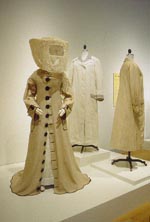
Madeline: "Travel has changed and the means of travel have changed.
And as they have done that, art and design have responded to it."
While some perhaps were stooges, full-service gas station attendants
were at least on hand once upon a time. A time when people just
didn't go for a drive, they went motoring.
Madeline: "We've got a few motoring coats from the first decade of
the 20th century and a motoring veil and it's made of lace and lined
with chiffon. And it's meant to fit over the woman's hat and to
protect her hairdo and her clothing from dust and from being
disarranged by wind."
Where did one find a motoring veil and other such items? Why, in a
Saks automobile apparel catalogue, of course, also on display at the
exhibit.
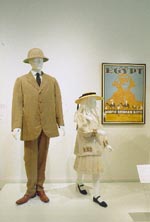
Madeline: "There are pages of motoring coats: long leather coats with
fur linings, rubber coats for protection from the rain, these
enveloping overall things that look like ponchos but they cover
everything including the steering wheel and the seat."
Tom: "This is something you'd wear?"
Madeline: "This is something you'd put on with a hood and drape it
over the steering wheel because cars were open. They didn't have
canopies and they didn't have windscreens and you sat up very high
and you were very exposed."
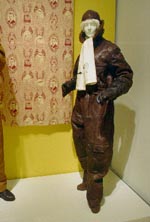
Protecting passengers from the means of transportation themselves was
another important function of travel clothing during this era. Early
airplane engines, for instance, spewed oil everywhere. The solution?
The one-piece flying suit: coveralls of cotton or fur-lined leather
that not only protected clothing from oil stains but provided warmth
while soaring through the chilly upper reaches of the atmosphere in
an unheated plane.
Though it's hard to believe airplane food was ever that good, air
travel of course eventually became more civilized. Ageing boomers
like myself even recall the days when people used to get dressed up
to get on a plane. And even though we're now traveling to more places
around the world than ever before, you have to admit when you start
comparing, say, your average carry-on bag with the likes of a French
designer steamer trunk, we're just not doing it with quite as much as
style we used to.
At the Rhode Island School of Design in Providence, I'm Tom Verde for
The Savvy Traveler.
Savvy Resources:
- Rhode Island School of Design
http://www.risd.edu/
- The Rhode Island School of Design Museum
224 Benefit Street, Providence, RI 02903
401-454-6500
|








 The popular, though unsubstantiated, origin of the word posh
is that it's an acronym for "Port Out, Starboard Home", where the
first class berths were on Titanic-era luxury liners. While this
theory is questionable, there's no doubt that the accommodations
on-board these ships were, well, pretty posh.
The popular, though unsubstantiated, origin of the word posh
is that it's an acronym for "Port Out, Starboard Home", where the
first class berths were on Titanic-era luxury liners. While this
theory is questionable, there's no doubt that the accommodations
on-board these ships were, well, pretty posh.